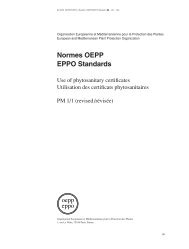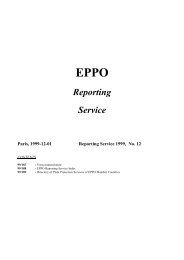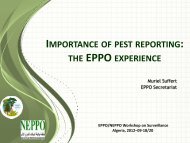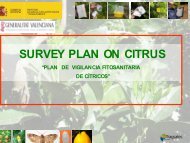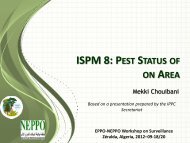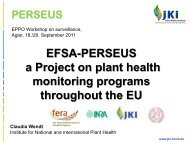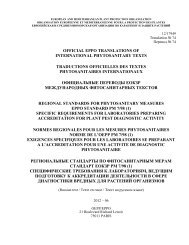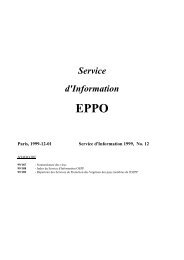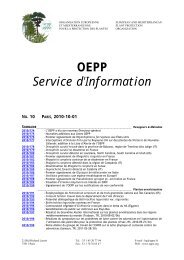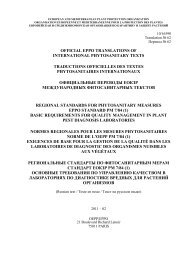EPPO Reporting Service - Lists of EPPO Standards - European and ...
EPPO Reporting Service - Lists of EPPO Standards - European and ...
EPPO Reporting Service - Lists of EPPO Standards - European and ...
You also want an ePaper? Increase the reach of your titles
YUMPU automatically turns print PDFs into web optimized ePapers that Google loves.
<strong>EPPO</strong> <strong>Reporting</strong> <strong>Service</strong> – Invasive Plants<br />
Species <strong>of</strong> Cactaceae Casual Locally Widely<br />
established established<br />
Opuntia maxima IT ES, FR, HR,<br />
PT<br />
Opuntia microdasys FR, PT ES<br />
Opuntia monacantha CZ, DE,<br />
ES<br />
FR<br />
Opuntia phaeacantha AT, ES IT<br />
Opuntia robusta IT<br />
Opuntia rosea ES<br />
Opuntia stricta PT ES, FR, IT<br />
Opuntia subulata PT ES, FR IT<br />
Opuntia tuna FR, IT ES<br />
Source: Essl F, Kobler J (2008) Spiny invaders – Patterns <strong>and</strong> determinants <strong>of</strong> cacti invasion<br />
in Europe. Flora 204, 485-494.<br />
Additional key words: invasive alien plants Computer codes: AUQCY, CEEUR, HCRTA, HCRUN, MHAPO,<br />
OPUAP, OPUCR, OPUDE, OPUDI, OPUEN, OPUEX, OPUHJ,<br />
OPUHU, OPUFI, OPUIM, OPUMI OPURS, OPUSP, OPUST, OPUVU,<br />
OPUMX, OPUPH, OPURO, OPUTN, PLEHP, PRJFC<br />
2010/021 New records <strong>of</strong> alien <strong>and</strong> invasive plants in Georgia<br />
Within the framework <strong>of</strong> a Swiss-Georgian research project, literature sources <strong>and</strong> field<br />
surveys were compiled in order to prepare an inventory <strong>of</strong> the alien flora <strong>of</strong> Georgia. The<br />
Georgian vascular flora includes 4200 taxa, <strong>of</strong> which 460 are alien. Of these 460 alien<br />
species, 80 are cultivated, <strong>and</strong> the 380 remaining ones are either considered<br />
subspontaneous, adventive, naturalized or invasive. Alien species thus represent 8.9% <strong>of</strong><br />
the flora <strong>of</strong> Georgia. Almost a third <strong>of</strong> all alien species recorded in Georgia have been<br />
introduced from Asia (33%). Of these, approximately 90% originate from East Asia. A high<br />
number <strong>of</strong> species are <strong>of</strong> Mediterranean origin (22%), <strong>and</strong> over the recent years, an<br />
increasing number <strong>of</strong> plant invaders <strong>of</strong> North American origin (17%) have been recorded in<br />
the western parts <strong>of</strong> Georgia. Plant invaders from Europe (13%) are mainly from Atlantic<br />
Europe.<br />
Among the 16 species considered to be invasive in Georgia, 10 originate from Asia <strong>and</strong> 4<br />
from North America. No <strong>European</strong> or Mediterranean species have become invasive so far,<br />
although many species <strong>of</strong> these origins are now naturalized in Georgia.<br />
The following 16 alien plants are considered invasive in Georgia, their origin, life form <strong>and</strong><br />
ecological group are indicated, as well as their distribution in the <strong>EPPO</strong> region according to<br />
the DAISIE database:<br />
Species Origin Life form Ecological group <strong>EPPO</strong> region<br />
Ailanthus altissima (Simaroubaceae)<br />
(<strong>EPPO</strong> List <strong>of</strong> Invasive Alien Plants)<br />
E-Asia Tree Dry grassl<strong>and</strong>s Widespread<br />
Ambrosia artemisiifolia (Asteraceae)<br />
(<strong>EPPO</strong> List <strong>of</strong> IAP)<br />
N-Am. Annual Ruderal Widespread<br />
Clerodendrum bungei (Verbenaceae) E-Asia Shrub Ruderal /<br />
Crassocephalum crepidioides<br />
(Asteraceae)<br />
S-Am. Annual Ruderal TR<br />
Miscanthus sinensis (Poaceae) E-Asia Perennial Ruderal Azores (PT), IT, TR<br />
Opuntia humifusa (Cactaceae) N-Am. Shrub Dry grassl<strong>and</strong>s ES, FR, GR, IT<br />
21




